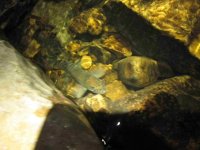langcliffe
Well-known member
adam said:From what he says about the Ingleborough Cave trout, that suggests there are trout in Fell Beck. Has anyone seen fish in there?
What a fascinating video - I didn't know it existed. I remember being one of the party that collected that poor fish with Dick Glover. It came from Lake Avernus, if I remember rightly, and we went in there specifically to bring one out. It survived its journey out of the cave, but died a few days later in a Lancaster University biology lab fish tank. I'm glad that it didn't die totally in vain.
We were convinced at the time that it was blind - how wrong can one be.
I have never seen trout in Fell Beck, but CPC and BPC winch meet campers will have had more opportunity.
I'm not convinced by Graham's explanation of how the fish got there. Even if they fall down the shaft into a flooded Main Chamber, they would still have had to negotiate 30 metres of vertical boulders. I can imagine one fish finding a route down East Pot or West Pot, but with Lake Avernus and Lake Pluto supporting a reasonably-sized population and assuming that isn't atypical for the phreas between the Main Chamber and Beck Stream Cave, there would have to be an awful lot of lucky fishes.




